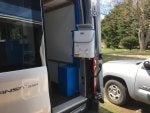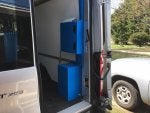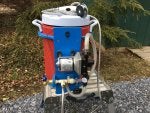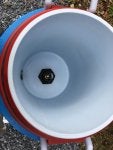This has been discussed, but I don't want to spend a lot of time looking for it, so this is how I heat shower water.
I hung an Eccotemp propane water heater on a swing-out by the back door. There's a box below it, vented out the bottom of the van, which contains a 10 lb propane tank.
I Installed a 300 watt 12VDC heating element in the bottom of a 5 gallon Rubbermaid drink cooler. The tap was replaced with a through-hull fitting plumbed to a pump. The output of the pump feeds a shower head with valve and a hose bib.
Water can be heated either of two ways; electrically with the element or by using the Eccotemp. Power for the element comes from one of the CCP taps through a 40A breaker and a relay operated by one of the up-fitter switches. During the last hour of driving, I can flip the switch and have hot water when I arrive. When camped, water is heated by pumping through the hose bib to the Eccotemp and back to the cooler until the desired temperature is reached and the bib is closed. When it's time to shower, the pump supplies the shower head.
This year, I plan to upgrade to a permanent Isotemp water heater, water tank and shower.
I hung an Eccotemp propane water heater on a swing-out by the back door. There's a box below it, vented out the bottom of the van, which contains a 10 lb propane tank.
I Installed a 300 watt 12VDC heating element in the bottom of a 5 gallon Rubbermaid drink cooler. The tap was replaced with a through-hull fitting plumbed to a pump. The output of the pump feeds a shower head with valve and a hose bib.
Water can be heated either of two ways; electrically with the element or by using the Eccotemp. Power for the element comes from one of the CCP taps through a 40A breaker and a relay operated by one of the up-fitter switches. During the last hour of driving, I can flip the switch and have hot water when I arrive. When camped, water is heated by pumping through the hose bib to the Eccotemp and back to the cooler until the desired temperature is reached and the bib is closed. When it's time to shower, the pump supplies the shower head.
This year, I plan to upgrade to a permanent Isotemp water heater, water tank and shower.








